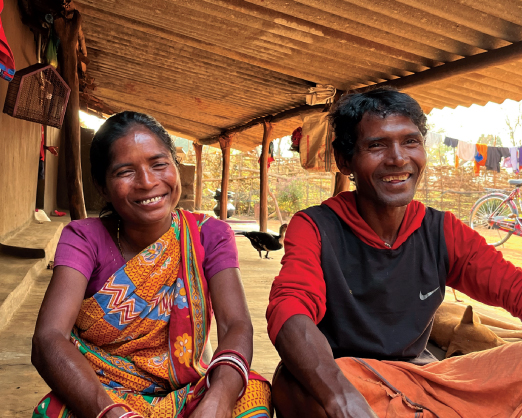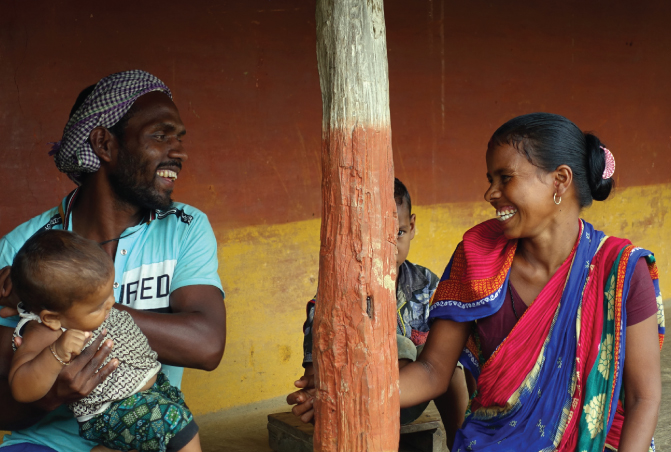Way to grow
A livelihoods project in Odisha, involving Axis Bank Foundation and the Tata Trusts, is turning the tide for 30,000 farmer families once on the edge
When you have a family of 12, it’s always a stretch to provide well for every member. That’s what 40-year-old Damodar Hansda and his wife, Mandoi, had to deal with all the time. Their mud hut accommodated the couple’s four children, four nieces and nephews, and Mr Hansda’s elderly parents as well. There was never enough room or food.
The Hansdas, who hail from Panabahali village in Odisha’s Jajpur district, used to cultivate paddy and work in a nearby railway yard, earning about ![]() 60,000 a year, nowhere close to what was needed to even live by. “We were hard-pressed to make ends meet,” says Mr Hansda. “My wife and I would always talk about finding ways to increase our income, but we didn’t know what else to do.”
60,000 a year, nowhere close to what was needed to even live by. “We were hard-pressed to make ends meet,” says Mr Hansda. “My wife and I would always talk about finding ways to increase our income, but we didn’t know what else to do.”
Then, in 2015, staff from Collectives for Integrated Livelihood Initiatives (CInI), an associate organisation of the Tata Trusts, visited Mr Hansda’s area and explained to farmers how they could generate more money from their modest land holdings. “We went to Harichandanpur in Keonjhar district to see a drip-farming project that we could adopt,” adds Mr Hansda. “We came back and, with CInI’s support, created a water asset and began using drip irrigation in our fields.”
Mr Hansda soon started growing bitter gourd, while continuing to cultivate paddy. And he branched out into rearing goats. What all of this has wrought is remarkable: the Hansdas now earn more than ![]() 200,000 a year.
200,000 a year.
As with so many families in rural India, the first priority for use of the increased income was a proper house. “I replaced my mud hut with a brick-walled home with a proper roof,” says Mr Hansda, who has also purchased a motorcycle. And he’s not resting on his gains. “I’m planning to do drip farming on another plot of land.”
The Hansdas are one among some 11,000 families in Odisha who are part of the Lakhpati Kisan livelihood programme. Launched in 2015 by CInI in Jharkhand, Maharashtra, Gujarat and Odisha, the initiative aims to bring 101,000 rural households from across India out of poverty — and irreversibly so — by diversifying and enhancing their sources of income. Farmers become lakhpatis when they start earning at least ![]() 120,000 per annum for several years.
120,000 per annum for several years.
In search of scale
“In Odisha we expect to help at least 30,000 farmer families become lakhpatis in the next five years,” says Ganesh Neelam, zonal head, central and east, with the Tata Trusts. “We now have Axis Bank Foundation [ABF] as a key partner in this endeavour and, with their support, we want to see how we can scale up the initiative.”
CInI is the anchor in the programme while the Trusts and ABF provide monetary support. The Trusts’ partnership with ABF started in 2019. In the first phase of the collaboration, ABF supported the Trusts-run Lakhpati Kisan projects in Rajasthan, Gujarat, Jharkhand and Uttarakhand.
“The idea behind the partnership was to see how community ownership and empowerment could be strengthened, along with ensuring sustainable livelihoods in these four states,” adds Mr Neelam. “ABF backed the programme in four states for four years and, when it got over a year ago, they were more than happy to look at Odisha.”
CInI started with Harichandanpur in Keonjhar district, where a cluster of 20-25 villages was targeted. The programme has now spread to Mayurbhanj district as well. “Entering a new geography brought its own challenges, and opportunities as well,” says Santanu Dutta, the CInI team leader in Odisha. Convincing farmers who had cultivated only paddy for generations to do something more was a tough task, as was winning community acceptance.

“We spent a lot of time with the community to make them understand how we could work closely with them. Other than agriculture, the locals were dependent on migration, either to distant cities or to the nearby steel plant, where they often got difficult and dangerous jobs. It brought them money, but it was hard labour.”
Jump to the present and the circumstances of the communities in the programme have improved substantially. They have got deeper — and wider in terms of spreading their bets — into agriculture, while adding allied livelihood options such as livestock rearing to their income-generation bag.
Podhi Majhi of Kusumjudi village in Harichandanpur was sceptical initially about branching out, though her family had reason enough to do that. Her husband, Dokhino, worked as a labourer and the Majhis also sold forest produce. They made barely ![]() 40,000 a year from both.
40,000 a year from both.
“We lived in a state of constant financial insecurity,” says Ms Majhi. “Then CInI told us about the benefits of ‘income layering’ and the various opportunities available through the Lakhpati Kisan initiative. They organised awareness sessions, training programmes and arranged field visits to show us successful examples in other villages. They convinced us with their knowledge and expertise.”

The Majhi family now makes between ![]() 120,000 and 150,000 a year. About 80% of their income comes from commercial vegetable cultivation, an improved paddy crop and livestock rearing. They continue to sell forest produce and Mr Majhi still works as a labourer. But these days he can afford to stay home when he wants, and work on his farm instead.
120,000 and 150,000 a year. About 80% of their income comes from commercial vegetable cultivation, an improved paddy crop and livestock rearing. They continue to sell forest produce and Mr Majhi still works as a labourer. But these days he can afford to stay home when he wants, and work on his farm instead.
For Natha Gagrai, 25, of Rugudipanga village in Keonjhar, the most persuasive part of CInI’s exertions was the ‘exposure’ trips to the nearby Tarajhar and Kataghati villages to see drip-irrigation projects. “We spoke to farmers there and learned how their lives have improved,” says Mr Gagrai. “After that, I was more than ready to do this.”
Firmer financial ground
Mr Gagrai’s reward, down the line, is an annual income of ![]() 244,000 from high-value vegetables and a side business in poultry. His family of four is on firmer ground than ever before.
244,000 from high-value vegetables and a side business in poultry. His family of four is on firmer ground than ever before.
Built into the Lakhpati Kisan programme is an important entity called the farmer producer company (FPC). This collective facilitates various benefits for farmers in the form of services, from finding good quality seeds and saplings — increasingly being grown in polyhouse nurseries in this area by local entrepreneurs — to introducing superior farming techniques and equipment, and improving crop management in general.
The FPC, importantly, ensures market linkages and a fair price for cultivators by eliminating the notorious middleman. It operates like a corporate body, with its own board of directors and a well-defined agenda.
The real success of the Lakhpati Kisan programme is to be seen on the ground and families like the Gagrais and the Majhis are testament to that. “The programme has been a boon,” says Ms Majhi. “We have a stable income and can afford better food, education for our children and necessary healthcare. We feel more secure about the present and more hopeful about the future.”

